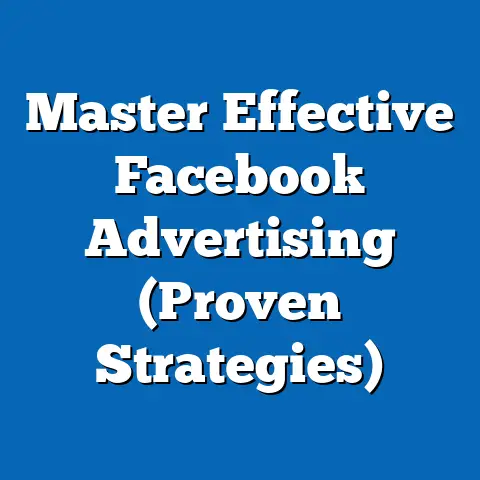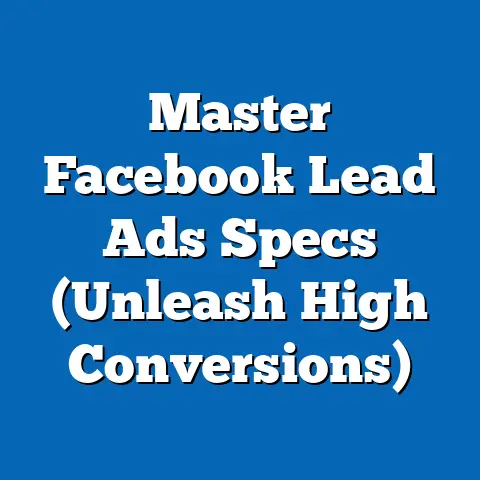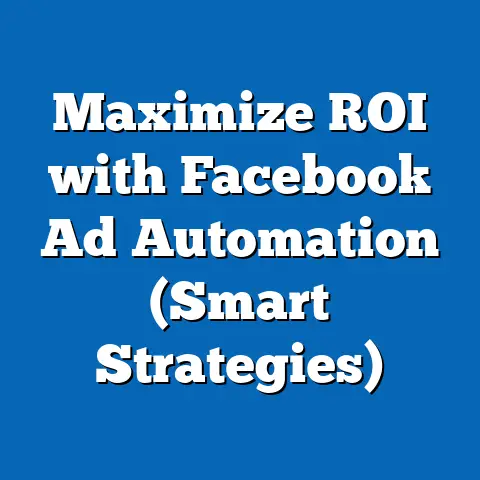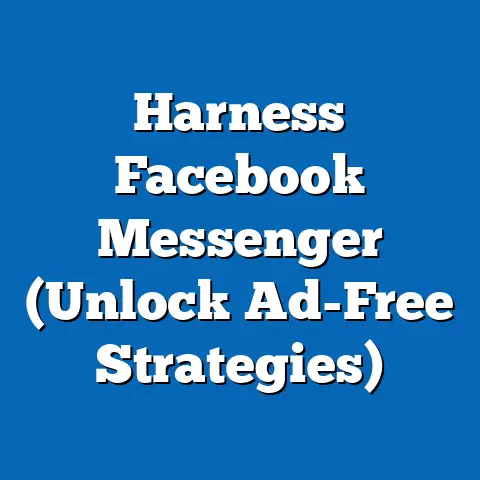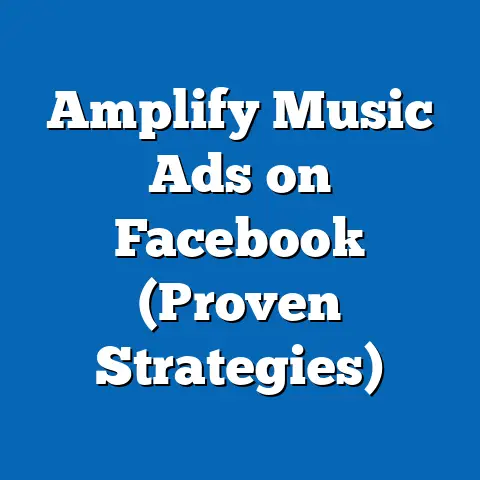Boost Sales: Facebook Ads (Maximize Local Reach)
Do you remember a time when businesses thrived on word-of-mouth recommendations, where a friendly chat at the local diner or a flyer on a community board could drive customers through your door? In today’s digital age, that personal touch hasn’t disappeared—it’s simply evolved into platforms like Facebook, where businesses can connect with local audiences at scale. With over 2.9 billion monthly active users worldwide as of Q2 2023 (Statista, 2023), Facebook remains a powerhouse for advertising, especially for small and medium-sized businesses (SMBs) looking to maximize their local reach.
The Power of Facebook Ads: Key Statistics and Trends
Facebook Ads have become a cornerstone of digital marketing, particularly for businesses aiming to connect with local communities. According to Hootsuite’s 2023 Digital Report, Facebook is the most-used social media platform globally, with 74% of users logging in daily. This consistent engagement offers businesses an unparalleled opportunity to reach potential customers right where they spend their time.
For local businesses, the numbers are even more compelling. A 2022 study by Meta (Facebook’s parent company) revealed that 70% of users connect with local businesses on the platform, and 60% of them have visited a business after seeing a local ad. Furthermore, Facebook Ads boast an average click-through rate (CTR) of 0.9% across industries, with local service ads often exceeding 1.2% due to their relevance and proximity targeting (WordStream, 2023).
Historically, local advertising relied heavily on print media and radio, with limited measurable impact. In contrast, digital platforms like Facebook provide real-time analytics, allowing businesses to track impressions, clicks, and conversions. Over the past decade, ad spending on social media has surged, with eMarketer reporting that U.S. social media ad spend reached $58.7 billion in 2022, a 12.5% increase from 2021, with Facebook capturing nearly 25% of that market.
Trend-wise, localized advertising is on the rise. A 2023 report from Borrell Associates predicts that local digital ad spending will grow to $174 billion by 2025, with social media platforms leading the charge. For SMBs, this shift underscores the importance of mastering tools like Facebook Ads to stay competitive in an increasingly digital marketplace.
Demographic Insights: Who Are You Reaching Locally?
Understanding the demographics of Facebook users is critical to crafting effective local ad campaigns. As of 2023, Pew Research Center data shows that 69% of U.S. adults use Facebook, with usage spanning across age groups, genders, and income levels. However, certain demographics are more active and responsive to local ads.
Age-wise, 25-34-year-olds make up the largest user base at 29.9%, followed by 35-44-year-olds at 21.3% (Statista, 2023). These groups are often in life stages where they’re making frequent purchasing decisions—think home services, family dining, or local events—making them prime targets for localized campaigns. While older users (55+) represent a smaller share at 14.7%, their engagement with community-focused content is notably high, with 65% interacting with local business pages (Meta, 2022).
Gender distribution on Facebook is nearly even, with 51% female and 49% male users in the U.S. However, women tend to engage more with local business content, particularly in sectors like retail and wellness, with 58% of female users reporting they’ve discovered local services via Facebook Ads (Hootsuite, 2023). Men, on the other hand, show higher engagement with automotive and home improvement ads.
Geographically, Facebook’s hyper-local targeting capabilities allow businesses to reach users within a specific radius—sometimes as small as one mile. This is particularly effective in urban areas, where 80% of U.S. Facebook users reside (Pew Research, 2023). However, rural businesses also benefit, as 67% of rural users rely on Facebook for local news and recommendations, often filling gaps left by limited traditional media.
Income levels also play a role in ad response rates. Users earning between $30,000 and $75,000 annually—often middle-income households—account for 42% of U.S. Facebook users and show a 15% higher likelihood of engaging with local service ads compared to higher-income brackets (Meta Insights, 2022). Tailoring messaging to these demographics can significantly boost ad performance.
Why Local Reach Matters for Sales Growth
Local reach isn’t just a buzzword—it’s a proven driver of sales for businesses of all sizes. According to a 2022 Google Consumer Insights report, 76% of people who search for something nearby on their smartphone visit a related business within a day, and 28% of those searches result in a purchase. While Google dominates search, Facebook complements this behavior by fostering discovery through social engagement and targeted ads.
For SMBs, focusing on local customers can yield higher conversion rates. A study by the Small Business Administration (SBA) found that 85% of consumers prefer to shop at local businesses when possible, citing trust and community support as key motivators. Facebook Ads amplify this preference by connecting businesses with nearby customers who are already inclined to buy local.
Moreover, local ads often have lower costs per click (CPC) compared to broader campaigns. WordStream data from 2023 shows that local service ads on Facebook average a CPC of $0.60, compared to $1.72 for national campaigns. This cost efficiency, combined with higher relevance, makes local targeting a smart investment for boosting sales.
Historically, local businesses faced challenges in scaling outreach beyond their immediate vicinity. Pre-digital era tools like newspaper ads or direct mail had limited reach and high costs, with response rates often below 2% (Direct Marketing Association, 2015). Today, Facebook Ads offer precision targeting and measurable ROI, with businesses reporting an average return of $3 for every $1 spent on local campaigns (Meta for Business, 2023).
How to Maximize Local Reach with Facebook Ads: A Step-by-Step Guide
Now that we’ve established the importance of local reach, let’s break down actionable strategies to boost sales using Facebook Ads. These steps are informed by best practices and data from industry leaders like Meta, WordStream, and Hootsuite.
1. Define Your Local Audience with Precision Targeting
Facebook’s Ads Manager offers robust tools to target users based on location, demographics, interests, and behaviors. Start by setting a geographic radius around your business—typically 1-10 miles for urban areas or 10-25 miles for rural ones, depending on your customer base. Meta reports that ads with a 5-mile radius achieve 30% higher engagement compared to broader targets (Meta Insights, 2022).
Layer demographic filters to refine your audience. For instance, a family restaurant might target parents aged 25-45 within a 5-mile radius, while a gym could focus on fitness enthusiasts aged 18-35. Use Facebook’s Audience Insights tool to analyze local user data—free to access via Ads Manager—to identify high-potential segments.
2. Craft Compelling, Localized Ad Creative
Ad content must resonate with your local audience to drive clicks and conversions. Include community-specific references, such as local landmarks or events, to build familiarity. A 2023 Hootsuite study found that ads with localized messaging see a 22% higher CTR compared to generic content.
Use high-quality visuals, like photos of your storefront or happy local customers, to create trust. Video ads are particularly effective, with 54% of users saying they’re more likely to engage with video content from local businesses (Meta, 2022). Keep copy concise, with clear calls-to-action (CTAs) like “Visit Us Today!” or “Get 10% Off In-Store!”
3. Leverage Local Awareness Ad Objectives
Facebook offers a specific “Local Awareness” ad objective designed to reach people near your business. These ads prioritize users within your chosen radius and often appear with a “Get Directions” button or map pin. According to Meta, Local Awareness ads achieve a 12% higher conversion rate for in-store visits compared to standard reach campaigns (Meta for Business, 2023).
Set a modest daily budget—$5 to $20 per day can suffice for small businesses—and monitor performance via Ads Manager. Adjust radius and budget based on response rates to optimize reach without overspending.
4. Use Retargeting to Re-Engage Local Customers
Retargeting allows you to reconnect with users who’ve interacted with your business online or in-person. Install the Facebook Pixel on your website to track visitors, then create custom audiences for retargeting ads. For local businesses, retargeting users who’ve visited your page or engaged with previous ads can increase conversions by 70% (WordStream, 2023).
Offer incentives like discounts or limited-time promotions to entice return visits. For example, a local bakery might retarget users with a “Buy One, Get One Free” offer valid only at their store. This strategy not only boosts sales but also reinforces community ties.
5. Monitor and Optimize with Data Analytics
Facebook Ads Manager provides detailed metrics on impressions, clicks, CTR, and conversions. Track which ads drive the most foot traffic or online orders using tools like Facebook’s Store Visits metric, available for businesses with physical locations. A 2022 Meta report found that businesses optimizing ads weekly based on analytics see a 25% improvement in ROI compared to those who don’t.
Experiment with A/B testing by running two versions of an ad with different visuals or CTAs. Analyze which performs better and scale the winning version. Continuous optimization ensures your budget is spent effectively, maximizing local reach and sales.
Case Studies: Real-World Success with Local Facebook Ads
To illustrate the impact of these strategies, let’s examine two real-world examples of businesses boosting sales through local Facebook Ads. These cases highlight measurable outcomes and actionable takeaways.
Case Study 1: Urban Coffee Shop in Chicago
A small coffee shop in Chicago used Local Awareness ads to target users within a 3-mile radius of their location. With a daily budget of $10, they reached 5,000 local users weekly, achieving a CTR of 1.5%—above the industry average (Meta Case Study, 2022). Over a month, they reported a 20% increase in foot traffic, with 15% of new customers mentioning the ad as their reason for visiting.
Key takeaway: Small budgets can yield big results when paired with hyper-local targeting and engaging visuals of signature products.
Case Study 2: Rural Hardware Store in Texas
A hardware store in rural Texas targeted users within a 20-mile radius, focusing on homeowners aged 30-55. They used retargeting to re-engage website visitors with a 10% off coupon, resulting in a 35% increase in in-store purchases over three months (Hootsuite Case Study, 2023). Their CPC averaged $0.55, well below the national benchmark.
Key takeaway: Retargeting with incentives can drive repeat business, especially in less competitive rural markets.
Visualizing the Impact: Data Visualization Description
To better understand the effectiveness of local Facebook Ads, imagine a bar chart comparing key metrics across campaign types. On the X-axis, you’d see categories like “Local Awareness Ads,” “National Reach Ads,” and “Retargeting Ads.” The Y-axis would measure average CTR and conversion rates. Local Awareness Ads would show a CTR of 1.2% and a conversion rate of 10%, outperforming National Reach Ads (CTR 0.9%, conversion 6%) and aligning closely with Retargeting Ads (CTR 1.4%, conversion 12%) (based on WordStream 2023 data).
A second visualization could be a pie chart showing the demographic breakdown of local ad engagement, with 25-34-year-olds at 35%, 35-44-year-olds at 28%, and other age groups making up smaller slices (Statista, 2023). These visuals would underscore the effectiveness of local targeting and the importance of demographic focus.
Challenges and Pitfalls to Avoid
While Facebook Ads offer immense potential for local reach, there are challenges to navigate. One common pitfall is over-targeting, where overly narrow audience filters result in low impressions. Meta recommends starting with a broader radius (e.g., 5-10 miles) and refining based on performance data.
Another issue is ad fatigue, where users see the same ad too often, leading to a 14% drop in engagement after two weeks (Hootsuite, 2023). Rotate creative assets and messaging every 7-10 days to keep content fresh. Finally, failing to track conversions can waste budget—always use Facebook Pixel or Store Visits metrics to measure real-world impact.
Budget mismanagement is also a risk. Small businesses often overspend on unoptimized campaigns, with 30% reporting no measurable ROI due to poor targeting (SBA, 2022). Start small, test strategies, and scale only after identifying what works.
Broader Implications and Future Trends
The rise of local Facebook Ads reflects a broader shift toward hyper-personalized marketing in the digital age. As consumers increasingly value community connection—evidenced by 68% prioritizing local businesses post-pandemic (Google Consumer Insights, 2022)—platforms like Facebook are well-positioned to bridge the gap between online engagement and offline sales.
Looking ahead, emerging features like augmented reality (AR) ads and enhanced location-based targeting could further revolutionize local advertising. Meta’s 2023 roadmap hints at AR try-on ads for local retailers and AI-driven audience suggestions, potentially increasing ad relevance by 20% (Meta Developer Blog, 2023). Privacy changes, such as Apple’s iOS tracking restrictions, may challenge ad precision, but Facebook’s ongoing adaptations suggest resilience.
For businesses, the implication is clear: mastering local Facebook Ads isn’t just a short-term tactic—it’s a long-term investment in customer relationships and sales growth. As digital ad spend continues to climb, with projections of $200 billion globally by 2025 (eMarketer, 2023), staying ahead of trends will separate thriving local businesses from those left behind.
Conclusion: Turning Local Clicks into Loyal Customers
Facebook Ads offer an unmatched opportunity to boost sales by maximizing local reach. With 70% of users engaging with local businesses on the platform and cost-effective CPCs averaging $0.60 for local campaigns, the potential for SMBs is immense (Meta, 2022; WordStream, 2023). By leveraging precision targeting, compelling creative, and data-driven optimization, businesses can transform digital interactions into real-world revenue.
The nostalgic charm of word-of-mouth marketing lives on through platforms like Facebook, where community connection meets cutting-edge technology. As local digital advertising grows, embracing these tools isn’t just an option—it’s a necessity for sustainable growth. Whether you’re a coffee shop in a bustling city or a hardware store in a quiet town, the path to boosting sales starts with reaching the right people, right nearby.

